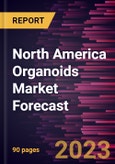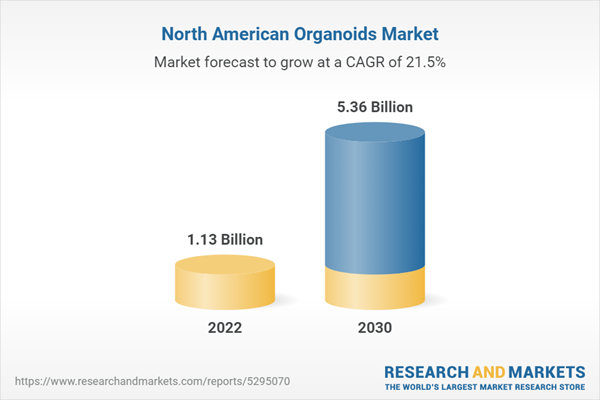Growing Adoption of Personalized Drugs Fuel North America Organoids Market
Personalized medicine, also known as precision medicine, is a medical model that practices procedures or drugs tailored to the individual patient based on the projected response or risk of disease. According to a study published by Personalized Medicine Coalition (PMC), personalized medicines accounted for only 5% of the new FDA-approved molecular entities in 2005, whereas they accounted for more than 25% in 2016. Additionally, 42% of all compounds and 73% of oncology compounds in the pipeline have the potential to be personalized medicines. Moreover, biopharmaceutical companies nearly doubled their R&D investment in personalized drugs over the past five years, which is likely to increase by 33% in the next five years. Biopharmaceutical researchers also predict a 69% increase in the development of personalized medicines over the coming five years. According to the latest report by the PMC (published in 2021), in the US, the number of personalized medicines in the market has risen from 132 in 2016 to 286 in 2020. The data was shared by tracking the numbers of personalized medicine since 2008 by the PMC.The implementation of organoids to create personalized drug therapies provides exciting opportunities for improving patient care. In addition, pharmacists play an essential role in increasing the demand for personalized medicines as they proactively educate and create awareness about precision medicine. Recent research has highlighted that more than 50% of consumers are interested in purchasing customized products or services. This demand has persuaded pharmaceutical research to develop more tailored treatments to make medicines safer and more effective.
Personalized cancer medicine is an approach to tailoring effective therapeutic strategies for each patient according to a tumor’s genomic characterization. There is an increasing demand for research in personalized tumor modeling to confirm the functional aspects of genomic drug response predictions in the preclinical setting. Numerous studies have highlighted the application of tumor organoids in personalized cancer medicine in terms of gene-drug association treatment, identification of new therapies, and prediction of patient outcomes.
Personalized cancer therapy applies specific treatments to each patient. Using personalized tumor models with similar characteristics to the original tumors may result in accurate predictions of drug responses in patients. Tumor organoid models have several advantages, such as conserving the molecular and cellular composition of the original tumor over pre-existing models. These advantages highlight the tremendous potential of tumor organoids in personalized cancer therapy, particularly in preclinical drug screening and predicting patient responses to selected treatment regimens.
North America Organoids Market Overview
The North America organoids market is segmented into the US, Canada, and Mexico. In 2022, the US held the largest share of the North America organoids market. Rising number of patients suffering from chronic conditions and viral diseases, increasing activities in research and development, commercialization of organoid models, and breakthroughs in stem cell research are the key factors propelling the market for organoids. Also, the growing funding and grants for organoid development are favoring market expansion.North America Organoid Market Revenue and Forecast to 2030 (US$ Million)
North America Organoids Market Segmentation
The North America organoid market is segmented into organ type, application, source, type, and country.Based on organ type, the North America organoid market is segmented into intestine, liver, stomach, pancreas, lung, brain, kidney, and others. The intestine segment held the largest share of the North America organoid market in 2022.
Based on application, the North America organoid market is segmented into developmental biology disease, pathology of infectious disease, regenerative medicine, drug toxicity and efficacy testing, drug discovery and personalized medicine, and others. The developmental biology disease segment held the largest share of the North America organoid market in 2022.
Based on source, the North America organoid market is bifurcated into pluripotent stem cells and organ-specific adult stem cell. The pluripotent stem cells segment held a larger share of the North America organoid market in 2022.
Based on type, the North America organoid market is segmented into instruments, consumables, and services. The consumables segment held the largest share of the North America organoid market in 2022.
Based on country, the North America organoid market is segmented int o the US, Canada, and Mexico. The US dominated the North America organoid market in 2022.
STEMCELL Technologies Inc, Cellesce Ltd, Organoid Therapeutics, 3Dnamics Inc, Thermo Fisher Scientific Inc, Merck KGaA, and InSphero are some of the leading companies operating in the North America organoids market.
Table of Contents
Executive Summary
At 21.5% CAGR, the North America Organoids Market is speculated to be worth US$ 5,359.72 million by 2030.According to this research, the North America organoids market was valued at US$ 1,125.01 million in 2022 and is expected to reach US$ 5,359.72 million by 2030, registering a CAGR of 21.5% from 2022 to 2030. Increasing demand for tumor modeling and biobanking as well as growing adoption of personalized drugs are the critical factors attributed to the North America organoids market expansion.
Organoids are microscopic and self-organizing 3D structures grown from stem cells in vitro. They review various structural and functional characteristics of their in vivo counterpart organs. This multipurpose technology has led to several novel human cancer models. It is now possible to create indefinitely expanding organoids starting from the tumor tissue of individuals suffering from a range of carcinomas. Alternatively, CRISPR-based gene modification allows the engineering of organoid models of cancer by introducing any combination of cancer gene alterations to normal organoids. Tumor organoids, when combined with immune cells and fibroblasts, become a model for the cancer microenvironment enabling immune-oncology applications. Also, recent studies have proved that organoids have a place in personalized medicine approaches.
The constant progress in organoid technology has paved the way for tumors and patient-centric 3D cultures of cells isolated from tumor biopsies. Over the past few decades, organoids have been generated from diverse human cancers associated with breast, colon, pancreas, prostate, bladder, and liver. Studies involving these models help in providing key facts about these malignancies. Due to constant advancements in the current scenario, tumoroid lines are increasingly being passed in vitro, opening new paths for a range of downstream applications. Moreover, 3D-based cultures offer added advantages over conventional 2D cancer-derived cell lines. Further, recent research and development activities have specified that tumoroid culturing is highly effective in allowing the collection of various cancer subtypes from a large pool of patients. As organoids can be easily derived and expanded from single cancer cells, the adoption of organoids to mimic intratumor diversification in culture is increasing, which, in turn, is propelling the North America organoids market.
Companies have been developing innovative biobanks for storing several biological samples, including tumors. For instance, OrganoidBase (developed by Crown Bioscience) consists of 342 tumor organoid models derived from patient-derived xenograft (PDX) models [i.e., PDX-derived organoids (PDXOs)]. PDXOs offer detailed information on histopathology, IC50, genomic, and transcriptomic analysis data associated with drug response; it also has an additional 217 models from primary patient samples. These PDXO models have varied indications, with multiple models derived from over 20 organ and tissue types. Crown Biosciences commercializes organoids in a 3D in vitro model derived using IP-protected Hubrecht Organoid Technology (HUB) protocols. Thus, such innovations are driving the market growth.
On the contrary, issues related to incorporation of organoids into existing workflows and dearth of skilled professionals hampers the North America organoids market.
Based on organ type, the North America organoids market is segmented into intestine, liver, stomach, pancreas, lung, brain, kidney, and others. The intestine segment held 23.3% share of North America organoids market in 2022, amassing US$ 261.72 million. It is projected to garner US$ 1,224.22 million by 2030 to expand at 21.3% CAGR during 2022-2030.
Based on application, the North America organoids market is segmented into developmental biology disease, pathology of infectious disease, regenerative medicine, drug toxicity and efficacy testing, drug discovery and personalized medicine, and others. The developmental biology disease segment held 29.3% share of North America organoids market in 2022, amassing US$ 330.17 million. It is projected to garner US$ 1,647.09 million by 2030 to expand at 22.2% CAGR during 2022-2030.
Based on source, the North America organoids market is bifurcated into pluripotent stem cells and organ-specific adult stem cell. The pluripotent stem cells segment held 72.7% share of North America organoids market in 2022, amassing US$ 817.37 million. It is projected to garner US$ 4,016.63 million by 2030 to expand at 22.0% CAGR during 2022-2030.
Based on type, the North America organoids market is segmented into instruments, consumables, and services. The consumables segment held 58.8% share of North America organoids market in 2022, amassing US$ 661.17 million. It is projected to garner US$ 3,400.92 million by 2030 to expand at 22.7% CAGR during 2022-2030.
Based on country, the North America organoids market has been categorized into the US, Canada, and Mexico. Our regional analysis states that the US captured 80.0% share of North America organoids market in 2022. It was assessed at US$ 899.96 million in 2022 and is likely to hit US$ 4,350.03 million by 2028, exhibiting a CAGR of 21.8% during 2022-2030.
Key players operating in the North America organoids market are STEMCELL Technologies Inc, Cellesce Ltd, Organoid Therapeutics, 3Dnamics Inc, Thermo Fisher Scientific Inc, Merck KGaA, and InSphero, among others.
In August 2021, InSphero AG announced that it is making its proprietary, patented 96- and 384-microwell plates available to researchers, enabling them to access the same plate technology used in the company’s flagship, assay-ready 3D InSight Human Liver Microtissues. The plates, engineered specifically for 3D cultures of spheroids and organoids, are available via InSphero’s online R&D Solutions Store. In February 2023, the collaboration will integrate the Thermo Scientific Momentum workflow scheduling software with the Celltrio RoboCell cell line automation platform to address the unmet market need for high-throughput automated cell line culturing and maintenance.
Companies Mentioned (Partial List)
A selection of companies mentioned in this report includes, but is not limited to:
- STEMCELL Technologies Inc
- Cellesce
- Organoid Therapeutics
- 3Dnamics Inc
- Thermo Fisher Scientific Inc
- Merck KGaA
- InSphero
Table Information
| Report Attribute | Details |
|---|---|
| No. of Pages | 90 |
| Published | November 2023 |
| Forecast Period | 2022 - 2030 |
| Estimated Market Value in 2022 | 1.13 Billion |
| Forecasted Market Value by 2030 | 5.36 Billion |
| Compound Annual Growth Rate | 21.5% |
| Regions Covered | North America |









